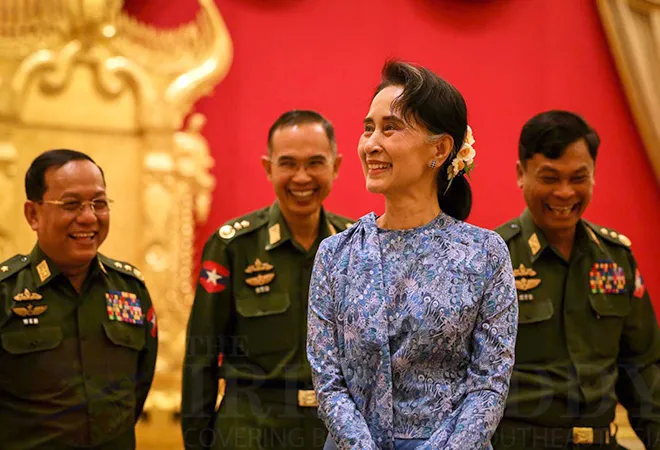
Aung San Suu Kyi, Myanmar’s State Counselor and Foreign Minister, is undertaking her first visit to India after taking charge of her official positions. Her five-day visit, India starting October 15, 2016, presents an opportunity for India to boost ties with her eastern neighbour.
During her stay, Suu Kyi is top leadership of the country, including Prime Minister Narendra Modi and External Affairs Minister Sushma Swaraj. In these meetings, bilateral relations, including trade and investment, are likely to be discussed. The visit also presents an opportunity for India to forge a strategic partnership with her South East Asian neighbour.
< style="color: #163449;">Importance as a strategic partner
Amidst simmering tensions on the western border, which have been a major irritant for India, the gradual improvement of relations with her eastern neighbours presents a bagful of opportunities. Myanmar is the only South East Asian country to share a land-border with India.
Suu Kyi will be attending the BRICS BIMSTEC Outreach Summit to be held in Goa on October 16. This Summit is being seen as an alternative channel for India’s regional engagement after the SAARC is struggling to convene its Summit this year.
BIMSTEC members Bangladesh and Sri Lanka, who are also members of the SAARC, are also participating in the Goa summit, further pushing Pakistan to the brink of isolation in the SAARC.
Suu Kyi’s participation is keenly looked forward by New Delhi as it gives an added strategic option to New Delhi. Myanmar, though not part of South Asia, is keen in forging alliance with India in countering terrorism. During Myanmar President U Htin Kyaw’s visit to India in August this year, he had agreed to cooperate in fighting terrorism and insurgency.
Myanmar’s cooperation is important for India to curb militancy in the bordering areas, especially the volatile North East Indian region. It is important to remember that India’s renewed engagement with Myanmar in the 1990’s was necessitated by the need for movement of troops in the insurgency-torn Kashmir.
Though Suu Kyi’s party, National League for Democracy, came to power in the 2015 general elections, there has not been much change in Myanmar’s foreign policy. In fact, its balancing act towards China is evident from Myanmar breaking its silence on the Permanent Court of Arbitration’s verdict on the South China Sea. The South East Asian country’s readiness to abide by international norms puts Myanmar’s western neighbour India a close ally.
< style="color: #163449;">Economic cooperation
Suu Kyi has just returned from the US where she has extracted a commitment from the outgoing President Barack Obama that the US will lift all economic sanctions on Myanmar. Though China’s economic might will be weighing on Suu Kyi’s mind, Myanmar would be seeking investment from India too, especially from the Indian private sector.
Suu Kyi is likely to seek investment in infrastructure, besides discussing the ongoing bilateral projects. Bolstering trade, that still is less than 3 billion US dollars, would be another item in the agenda of talks between Suu Kyi and the Indian Prime Minister.
New Delhi is keen on extending the BBIN sub-regional cooperation initiative to include Myanmar and Sri Lanka. BBIN sub-regional cooperation, that is a SAARC-minus-1 grouping, allows India to overcome Pakistan’s opposition to India’s overtures in the SAARC.
Myanmar’s interest in joining the South Asian regional associations like the SAARC could be leveraged by offering the country to join the BBIN initiative. A free-trade regime and an investment hub among the sub-regional countries could bring the much needed boost to their growing economies.
< style="color: #163449;">Soft power potential
Besides the economic and strategic matters, Suu Kyi’s election to the highest corridors of Myanmar’s polity has provided India a soft power potential. Suu Kyi is among the most prestigious visitors who were educated in India and then went on to climb the power ladders in their respective countries.
And for Myanmar, strengthening institutions is a priority while it is transitioning to become a democracy. Suu Kyi is likely to accept New Delhi’s offer made to President U Thin Kyaw to help revitalise democratic institutions in Myanmar.
Suu Kyi had visited Beijing in August this year while her visit to India was in 2012, just after she was freed from her long house-arrest. In such a scenario, Prime Minister Modi has his task cut out to nurture and take forward Suu Kyi’s long association with India in the interest of improving bilateral engagement.
The views expressed above belong to the author(s). ORF research and analyses now available on Telegram! Click here to access our curated content — blogs, longforms and interviews.




 PREV
PREV


